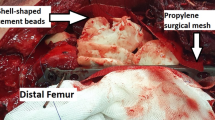Abstract
Objective
To compare the outcomes of patients with segmental bone loss who underwent repair with the induced membrane technique (IMT) with a matched cohort of nonunion fractures without bone loss.
Design
Retrospective analysis on prospectively collected data.
Setting
Academic medical center.
Patients
Two cohorts of patients, those with upper and lower extremity diaphyseal large segmental bone loss and those with ununited fractures, were enrolled prospectively between 2013 and 2020. Sixteen patients who underwent repair of 17 extremities with segmental diaphyseal or meta-diaphyseal bone defects treated with the induced membrane technique were identified, and matched with 17 patients who were treated for 17 fracture nonunions treated without an induced membrane. Sixteen of the bone defects treated with the induced membrane technique were due to acute bone loss, and the other was a chronic aseptic nonunion.
Main Outcome Measurements
Healing rate, time to union, functional outcome scores using the Short Musculoskeletal Functional Assessment (SMFA) and pain assessed by the Visual Analog Scale (VAS).
Results
The initial average defect size for patients treated with the induced membrane technique was 8.85 cm. Mean follow-up times were similar with 17.06 ± 10.13 months for patients treated with the IMT, and 20.35 ± 16.68. months for patients treated without the technique. Complete union was achieved in 15/17 (88.2%) of segmental bone loss cases treated with the IMT and 17/17 (100%) of cases repaired without the technique at the latest follow up visit. The average time to union for patients treated with the induced membrane technique was 13.0 ± 8.4 months and 9.64 ± 4.7 months for the matched cohort. There were no significant differences in reported outcomes measured by the SMFA or VAS. Patients treated with the induced membrane technique required more revision surgeries than those not treated with an induced membrane.
Conclusion
Outcomes following treatment of acute bone loss from the diaphysis of long bones with the induced membrane technique produces clinical and radiographic outcomes similar to those of long bone fracture nonunions without bone loss that go on to heal.
Level of evidence:
III.


Similar content being viewed by others
References
Bianchi-Maiocchi A, Aronson J (1991) Operative principles of ilizarov. Williams and WIlkins, Baltimore
Azi ML, De Almeida Teixeira AA, Cotias RB et al (2019) Induced-membrane technique in the management of posttraumatic bone defects. JBJS Essent Surg Tech. https://doi.org/10.2106/JBJS.ST.18.00099
Aurégan JC, Bégué T (2014) Induced membrane for treatment of critical sized bone defect: a review of experimental and clinical experiences. Int Orthop 38:1971–1978
Masquelet AC (2003) Muscle reconstruction in reconstructive surgery: Soft tissue repair and long bone reconstruction. Langenbeck’s Arch Surg 388:344–346
El-Hadidi TT, Soliman HM, Farouk HA, Radwan MAEM (2018) Staged bone grafting for the management of segmental long bone defects caused by trauma or infection using induced-membrane technique. Acta Orthop Belg 84(4):384–396
Pelissier P, Masquelet AC, Bareille R et al (2004) Induced membranes secrete growth factors including vascular and osteoinductive factors and could stimulate bone regeneration. J Orthop Res. https://doi.org/10.1016/S0736-0266(03)00165-7
Apard T, Bigorre N, Cronier P et al (2010) Two-stage reconstruction of post-traumatic segmental tibia bone loss with nailing. Orthop Traumatol Surg Res. https://doi.org/10.1016/j.otsr.2010.02.010
Littlefield CP, Wang C, Leucht P, Egol KA (2021) The basic science behind the clinical success of the induced membrane technique for critical-sized bone defects. JBJS Rev. https://doi.org/10.2106/JBJS.RVW.20.00206
Meinberg E, Agel J, Roberts CS (2018) Fracture and dislocation classification compendium. J Orthop Trauma 32:S1–S170
Morelli I, Drago L, George DA et al (2016) Masquelet technique: myth or reality? A systematic review and meta-analysis. Injury. https://doi.org/10.1016/S0020-1383(16)30842-7
Piacentini F, Ceglia MJ, Bettini L et al (2019) Induced membrane technique using enriched bone grafts for treatment of posttraumatic segmental long bone defects. J Orthop Traumatol. https://doi.org/10.1186/s10195-019-0522-6
Zappaterra T, Ghislandi X, Adam A et al (2011) Induced membrane technique for the reconstruction of bone defects in upper limb. A prospective single center study of nine cases. Chir Main. https://doi.org/10.1016/j.main.2011.06.005
Moghaddam A, Thaler B, Bruckner T et al (2017) Treatment of atrophic femoral non-unions according to the diamond concept: results of one- and two-step surgical procedure. J Orthop. https://doi.org/10.1016/j.jor.2016.10.003
Carlock KD, Hildebrandt KR, Konda SR, Egol KA (2019) Autogenous iliac crest bone grafting for the treatment of fracture nonunion is equally effective in elderly and nonelderly patients. J Am Acad Orthop Surg. https://doi.org/10.5435/JAAOS-D-18-00322
Taormina DP, Shulman BS, Karia R et al (2014) Older age does not affect healing time and functional outcomes after fracture nonunion surgery. Geriatr Orthop Surg Rehabil. https://doi.org/10.1177/2151458514532811
Konda SR, Littlefield CP, Carlock KD et al (2021) Autogenous iliac crest bone grafting for tibial nonunions revisited: does approach matter? Arch Orthop Trauma Surg. https://doi.org/10.1007/s00402-020-03735-6
Monroy A, Urruela A, Egol KA et al (2013) Distal Femur Nonunion Patients Can Expect Good Outcomes. Journal of Knee Surgery. https://doi.org/10.1055/s-0033-1349402
Funding
No funding was secured for this study.
Author information
Authors and Affiliations
Corresponding author
Ethics declarations
Conflict of interest
The authors have no conflicts of interest relevant to this study.
Ethical approval
All ethical standards were complied with in this study.
Informed consent
All subjects enrolled in this study were required to sign an informed consent form and were included in a database approved by, and regularly audited by the Institutional Review Board at our center.
Additional information
Publisher's Note
Springer Nature remains neutral with regard to jurisdictional claims in published maps and institutional affiliations.
Rights and permissions
Springer Nature or its licensor (e.g. a society or other partner) holds exclusive rights to this article under a publishing agreement with the author(s) or other rightsholder(s); author self-archiving of the accepted manuscript version of this article is solely governed by the terms of such publishing agreement and applicable law.
About this article
Cite this article
Konda, S.R., Boadi, B.I., Leucht, P. et al. Surgical repair of large segmental bone loss with the induced membrane technique: patient reported outcomes are comparable to nonunions without bone loss. Eur J Orthop Surg Traumatol 34, 243–249 (2024). https://doi.org/10.1007/s00590-023-03580-4
Received:
Accepted:
Published:
Issue Date:
DOI: https://doi.org/10.1007/s00590-023-03580-4




